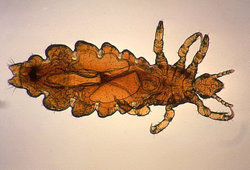The phone rings. It's the school nurse. "Come get your child," she says. "He has lice." Before you rush out to pick him up, know this: Just about everything you've ever been told about head lice is wrong. For starters, your child shouldn't have to leave school. In 2002 the American Academy of Pediatrics stated specifically that there is no medical reason to make kids miss classes because of lice. In fact, all it does is make your child an easy target. "Other kids make fun of them and it's just terrible as far as a child's self-esteem goes," says Dr. Barbara L. Frankowski, a Vermont pediatrician who served on the committee that drafted the lice guidelines.
Head lice don't carry disease and they are not a sign of a dirty home or a dirty child. You don't get lice by sharing hairbrushes or hats. It's a bit of a mystery how lice get spread from person to person, but the most likely transmission route seems to be direct head-to-head contact.
Another myth: You need to wash stuffed animals, clothes, blankets, sheets, and vacuum everything in sight. Not true. Lice die quickly when off a human head--usually within 24 hours. If your child has an infestation, the only thing you need to treat is the lice itself.
Unfortunately, that has become more difficult these days because improper use of over-the-counter lice treatments containing the pesticides permethrin or pyrethrin has led to a growing number of resistant lice. Too few parents follow the directions to the letter, says Richard J. Pollack, Ph.D., of the Department of Immunology and Infectious Diseases at Harvard School of Public Health in Boston. For instance, the shampoos, such as Nix, have to be applied to dry hair, but many parents use it on wet hair. Make sure you follow the instructions explicitly.
If over-the-counter products don't work after two tries, ask your doctor for prescription lice killers. Two are available, the first being lindane. It's gotten a bad reputation in the popular press, says Pollack, and has even been banned in California. "But it's been grossly misused," he says. The drug is supposed to be applied for four minutes, then promptly washed out. But many parents put it on for far longer periods, causing skin reactions.
The other chemical, malathion, calls for a single 10-hour application, which should kill all the lice and their eggs, he says. It should only be used on kids 6 and older. And keep your kids away from open flames or cigarettes; malathion is dissolved in alcohol and extremely flammable.
Of course, you could also do what people have done throughout the centuries--shave your kid's head. Without hair to cling to, head lice will fall off and die. Some boys won't mind this option at all.
COPYRIGHT 2004 Meredith Corporation



